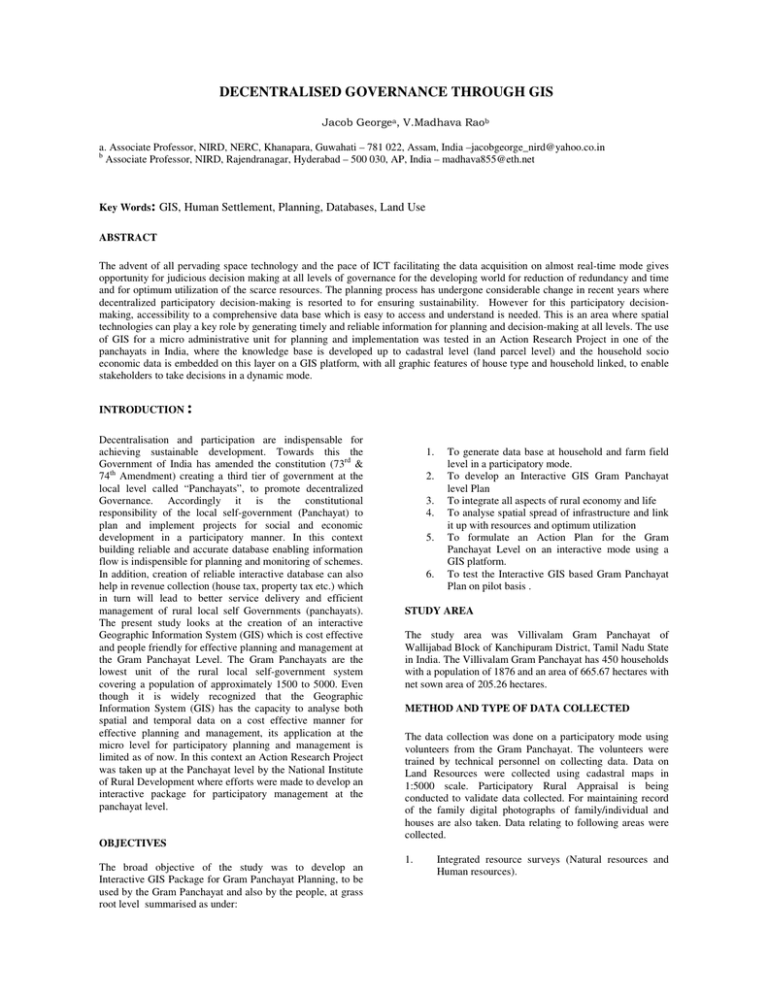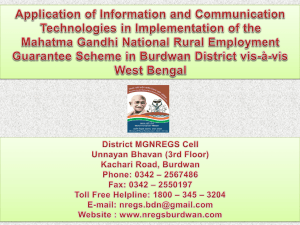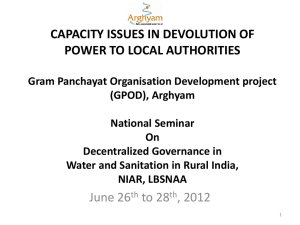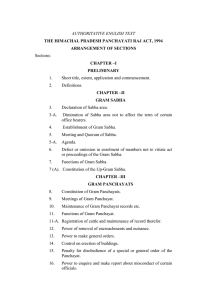DECENTRALISED GOVERNANCE THROUGH GIS
advertisement

DECENTRALISED GOVERNANCE THROUGH GIS a. Associate Professor, NIRD, NERC, Khanapara, Guwahati – 781 022, Assam, India –jacobgeorge_nird@yahoo.co.in b Associate Professor, NIRD, Rajendranagar, Hyderabad – 500 030, AP, India – madhava855@eth.net Key Words: GIS, Human Settlement, Planning, Databases, Land Use ABSTRACT The advent of all pervading space technology and the pace of ICT facilitating the data acquisition on almost real-time mode gives opportunity for judicious decision making at all levels of governance for the developing world for reduction of redundancy and time and for optimum utilization of the scarce resources. The planning process has undergone considerable change in recent years where decentralized participatory decision-making is resorted to for ensuring sustainability. However for this participatory decisionmaking, accessibility to a comprehensive data base which is easy to access and understand is needed. This is an area where spatial technologies can play a key role by generating timely and reliable information for planning and decision-making at all levels. The use of GIS for a micro administrative unit for planning and implementation was tested in an Action Research Project in one of the panchayats in India, where the knowledge base is developed up to cadastral level (land parcel level) and the household socio economic data is embedded on this layer on a GIS platform, with all graphic features of house type and household linked, to enable stakeholders to take decisions in a dynamic mode. INTRODUCTION : Decentralisation and participation are indispensable for achieving sustainable development. Towards this the Government of India has amended the constitution (73rd & 74th Amendment) creating a third tier of government at the local level called “Panchayats”, to promote decentralized Governance. Accordingly it is the constitutional responsibility of the local self-government (Panchayat) to plan and implement projects for social and economic development in a participatory manner. In this context building reliable and accurate database enabling information flow is indispensible for planning and monitoring of schemes. In addition, creation of reliable interactive database can also help in revenue collection (house tax, property tax etc.) which in turn will lead to better service delivery and efficient management of rural local self Governments (panchayats). The present study looks at the creation of an interactive Geographic Information System (GIS) which is cost effective and people friendly for effective planning and management at the Gram Panchayat Level. The Gram Panchayats are the lowest unit of the rural local self-government system covering a population of approximately 1500 to 5000. Even though it is widely recognized that the Geographic Information System (GIS) has the capacity to analyse both spatial and temporal data on a cost effective manner for effective planning and management, its application at the micro level for participatory planning and management is limited as of now. In this context an Action Research Project was taken up at the Panchayat level by the National Institute of Rural Development where efforts were made to develop an interactive package for participatory management at the panchayat level. OBJECTIVES The broad objective of the study was to develop an Interactive GIS Package for Gram Panchayat Planning, to be used by the Gram Panchayat and also by the people, at grass root level summarised as under: 1. 2. 3. 4. 5. 6. To generate data base at household and farm field level in a participatory mode. To develop an Interactive GIS Gram Panchayat level Plan To integrate all aspects of rural economy and life To analyse spatial spread of infrastructure and link it up with resources and optimum utilization To formulate an Action Plan for the Gram Panchayat Level on an interactive mode using a GIS platform. To test the Interactive GIS based Gram Panchayat Plan on pilot basis . STUDY AREA The study area was Villivalam Gram Panchayat of Wallijabad Block of Kanchipuram District, Tamil Nadu State in India. The Villivalam Gram Panchayat has 450 households with a population of 1876 and an area of 665.67 hectares with net sown area of 205.26 hectares. METHOD AND TYPE OF DATA COLLECTED The data collection was done on a participatory mode using volunteers from the Gram Panchayat. The volunteers were trained by technical personnel on collecting data. Data on Land Resources were collected using cadastral maps in 1:5000 scale. Participatory Rural Appraisal is being conducted to validate data collected. For maintaining record of the family digital photographs of family/individual and houses are also taken. Data relating to following areas were collected. 1. Integrated resource surveys (Natural resources and Human resources). 2 2. 3. 4. 5. 6. Surveys relating to basic infrastructure of the panchayat-roads, drinking water resources, schools etc. Household information, housing structure, type of material used in house construction, basic amenities like electricity, water, telephone etc. Photograph of the house and its members. Household-wise collection of data realating to house tax, water tax etc. The resource surveys using cadastral map in the scale of 1: 5000. Plot-wise information was collected. PROCESS METHODOLOGY The base data forms the attribute database and the maps, the spatial database. These databases are integrated in a GIS platform and an information system is developed. The developed information system is embedded with query facilities so as to make it interactive. The presentation was made by Arc View GIS Software and Map Object Software and the customisation was made by Map Object and Visual Basic. Flexibility is inbuilt in the Interactive GIS developed to adapt to new situations and environments. The pilot software is being provided to the Gram Panchayat and the GP functionaries are being trained to use the same. The Software’s used are Arc Info 3.5.1, Arc View 3.1, Map Object 2.0 and Visual Basic 6.0, for developing the Interactive GIS for Gram Panchayat Planning. The outputs on the Window Screen are placed for visualizing the Software capabilities and outcomes. The Software has the capabilities to update database and the files are saved in new databases, which facilitates comparison of data over time period, for studying the impact of schemes or programmes or development initiatives and detection of changes. The photographs of each household family members are embedded with the house at the back drop. The profile of each household is available. The Villivalam Gram Panchayat profile with graphics is also available at Gram Panchayat layer. All formats are placed in window format for ease in use and understanding at the local level with Visual Basic 6.0 Software. With training of one day, a person with high school qualification can operate the software and maintain the same. Any new parameters can be added and the software can be upgraded from time to time based on the need of the time, without losing any data. OBSERVATIONS The striking revelation in this study is the fact that local people are greatly enthusiastic in adapting to new technology and new way of working together and take lot of interest in knowing new ways of doing things. Secondly the people at the local level rise above political, economic and social affiliations, and express their solidarity in applying the new tools and technology in their day to day work. The women participation was quite encouraging, and were willing to adopt the real technology. The younger mass feel social upheaval and enhancement in their social status through exposure and use of new IT Tools at the local level. The people’s representatives give all encouragement and support and stand by the people in introduction of new technology and in new ways of doing things, irrespective of their political affiliations. The district and local administration takes great interest in introducing new IT Tools and request development of these tools with inbuilt functionality for day to day administrative use at all level, in improving their performance and effectiveness and express their support and cooperation in any attempt in this regard. REPLICABILITY The Interactive GIS developed at the Gram Panchayat can be replicated. There are also possibilities and potential available for adding additional features and making it a wide spectrum software. The database required may vary depending on the type of problem faced in a particular area. The level of social mobilization needed to ensure participation in data collection and analysis can also vary from place to place. CONCLUSION The user friendly interactive GIS for a micro administrative unit has helped in ensuring better participation of the stakeholders in decision making. The variation in the level of education of the community was bridged by pictorial representation of data. The project helped in empowerment of the community and generated land literacy. User friendly interactive GIS data base generated at a micro administrative unit (panchayat) can improve the efficiency of administration, improve resource mobilization and help in informed decision making. The software being simple and customized and open for modifications hold lot of promise for local level applications. The strong aspect of this software is the capabilities of liking wide graphic aspects, like photographs, audios, videos, imageries and analyzed maps etc , which project field realities and help taking appropriate decision making, by people themselves.




